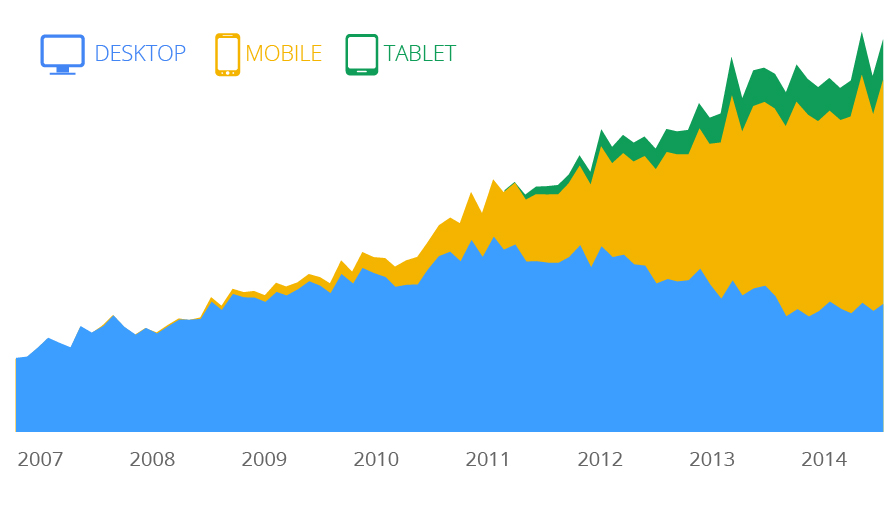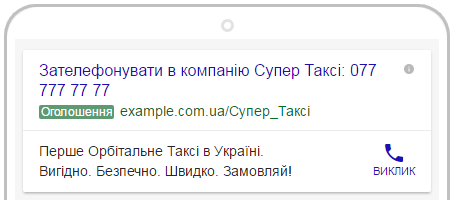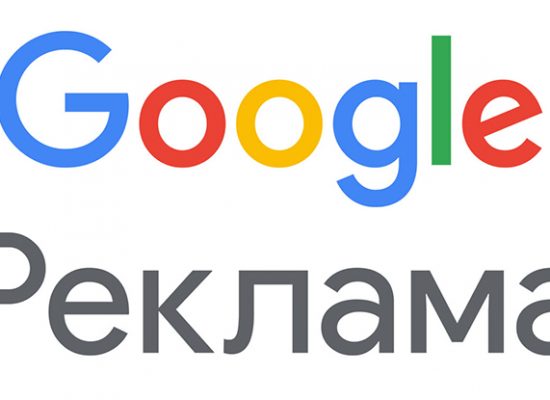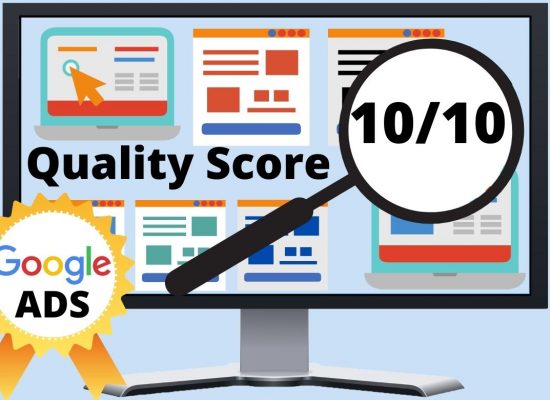Google search trends
In 2015, an important event took place, although not too noticeable to the general public - the number of search queries on Google from mobile devices exceeded the number of queries from desktops. Mobile traffic, which until recently was perceived as an addition to PC traffic, began to dominate.
In our country, as of 2016, about 40% users visited websites from mobile devices. Ukraine is in the global trend and this must be taken into account when working with contextual and media advertising.

What to do if your site is not optimized for smartphones
The best solution, of course, would be to redesign and adapt the site for smartphones and tablets. But what to do if online advertising is needed or used already now, but in the short term, website improvements are not included in your plans?
Many in this case simply turn off the display of ads on mobile, focusing exclusively on the PC. At first glance, this approach may seem rational, but it is not entirely true.
Conversion rates from smartphones may be lower than those from desktops. This is due, among other things, to the fact that placing an order on a compact display is less convenient, so some users who access the site from a pocket gadget will re-enter from a desktop and complete a transaction or order. If the site is not optimized for mobile, the number of users who leave the site will increase, but some of them will still remain and make a conversion action.
Conversion rates by device type need to be carefully analyzed and then based on the ratio of conversion rates, adjustments should be applied in the AdWords campaign settings.
For example, if your PC conversion rate is 1.5% and your mobile conversion rate is 1.2%, you would lower your mobile bids by (1 − 1.2/1.5) x 100% = 20%.

If your customers mainly find out the information they are interested in by phone (for example, a taxi service), it makes sense to use ads with only a phone number. Of course, you will not be able to get those users who wanted to get to know your site in the beginning, but the advantage is that you will pay for such calls in the same way as for regular clicks.

Separating traffic by device type
2016 brought a lot of innovations to Google AdWords, and a lot of them were related to mobile advertising. The new Rich Text ad format has become even more effective and visible on compact screens, and the ability to turn off ads on PC has made it possible to create separate campaigns for each type of device.
Why set up separate ad campaigns for mobile when you can adjust bids and create ads suitable for all devices within one campaign?
Firstly, people use different devices in different situations and often use different queries.
From a smartphone, the user often asks questions (what? how? where?), googles places and routes more often, and is more inclined to call. This should be used in ads, in calls to action, thereby increasing the relevance of the advertising text and increasing the CTR.

Second, the length limits for ad titles and descriptions, while fixed across devices, differ in the length of text actually displayed.
On desktop PCs, long titles can be truncated, Google officially recommends using no more than 33 characters in two titles if you want them to be guaranteed to be displayed in full. On mobile, this problem does not arise, the headings are displayed in 2 rows. You can see this when creating ads in the AdWords web interface in preview mode.

Also, the statistics related to the position and CTR of ads on Google search are closely related to the type of device - on a small screen, the top positions become even more clickable. This in turn affects your keyword bidding strategy. Thus, by setting up separate campaigns for smartphones and for PCs for each direction of contextual advertising, you can make the most of the specifics of search queries and display features of AdWords ads for any type of device.
Location targeting
 Geotargeting is one of the basic AdWords settings that can be applied in a very non-standard way. The fact is that Google determines the location of the user, first of all, by the IP address, which all devices connected to the 3G Internet in Ukraine have Kiev. If your ads target any Ukrainian cities other than Kyiv, you are missing out on about 20% potential customers who mostly use 3G smartphones.
Geotargeting is one of the basic AdWords settings that can be applied in a very non-standard way. The fact is that Google determines the location of the user, first of all, by the IP address, which all devices connected to the 3G Internet in Ukraine have Kiev. If your ads target any Ukrainian cities other than Kyiv, you are missing out on about 20% potential customers who mostly use 3G smartphones.
In order to get these customers, you need to create separate campaigns that will use keywords mentioning the target location (for example, if you advertise sushi delivery in Odessa, then use the keywords sushi delivery odessa, order sushi odessa, etc.) targeting the city of Kiev. To prevent wasting your budget, it is worth disabling impressions on desktop computers in such campaigns, since PCs account for only 5% of the total “pseudo-Kiev” traffic on average. Given that not all advertisers are aware of this feature of geotargeting, the competition will be lower, which will allow you to get additional clicks and conversions at a lower cost.
This specificity of AdWords has another side - if your advertising is aimed at Kyiv, and other regions of Ukraine are not targeted for you, you will be wasting money on useless traffic. This problem can be solved in several ways:
- Do not select the city of Kyiv in location targeting, select individual districts and target by radius.
The disadvantage of this option is that you may lose some of the potential impressions from the target location that the system did not attribute to a specific area or area. - Use of keywords linked to Kyiv or Kyiv toponyms, detailed study of negative keywords, in particular, non-target toponyms.
The disadvantage of this approach is the restrictions that are imposed on the use of key phrases and the impossibility of using this option in media advertising for audiences of interest.
Results
To successfully work with Google AdWords mobile advertising, do not forget that:
- It is necessary to follow trends, be aware of market changes and innovations of its key players.
- Responsive website design is necessary, but regardless of adaptability, analyze the behavior of all visitors, including mobile ones.
- The same requests from smartphones and computers are often due to different user needs.
- Expanded text ads have their own specifics of displaying on Google search, pay attention to their appearance when previewing.
- Kyiv traffic is not always really Kyiv.
Author: Head of contextual advertising department of the agency of strategic Internet marketing Star Marketing Alexander Kirsanov.







